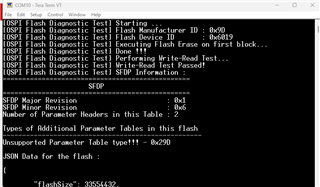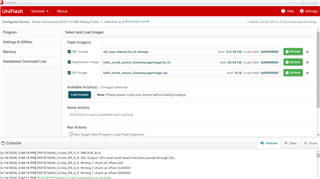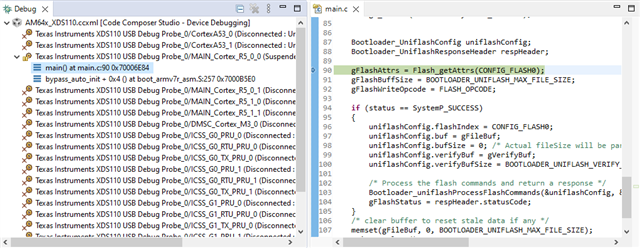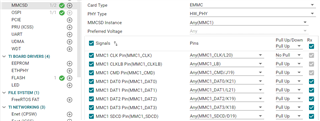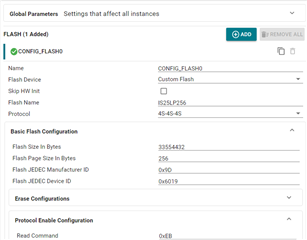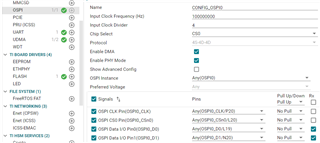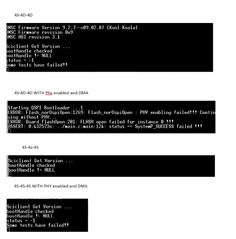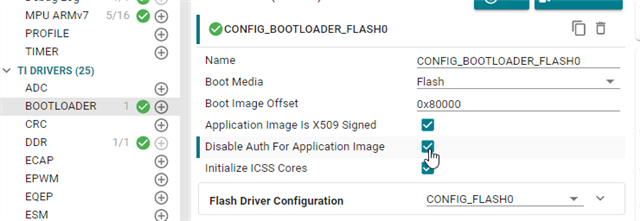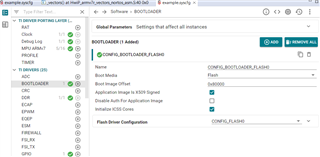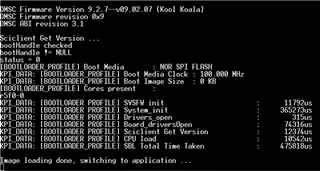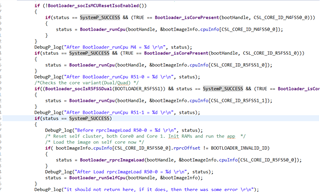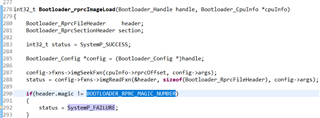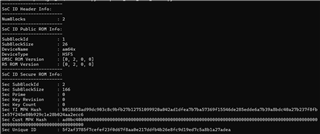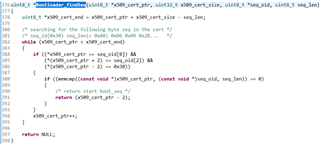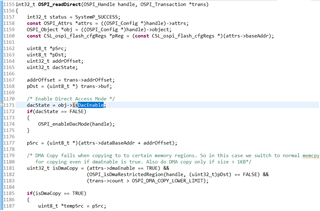Other Parts Discussed in Thread: UNIFLASH, SYSCONFIG, LP-AM243, AM2434
Tool/software:
Hi,
We have one custom board with AM2432 ALV chip and The Flash we select is IS25LP256D and in QSPI mode. Now we want to flash some hello world image into the board as bring up.
Below are steps I have done:
1. Follow AM243x MCU+ SDK: Adding Support For a Custom Flash Device (ti.com) , get the SDFM paramenters and save it into .json file .
----------------------------------------------------------------------------------------
Starting SOC Initialization ...
Resetting self cluster ...
[OSPI Flash Diagnostic Test] Starting ...
[OSPI Flash Diagnostic Test] Flash Manufacturer ID : 0x9D
[OSPI Flash Diagnostic Test] Flash Device ID : 0x6019
[OSPI Flash Diagnostic Test] Executing Flash Erase on first block...
[OSPI Flash Diagnostic Test] Done !!!
[OSPI Flash Diagnostic Test] Performing Write-Read Test...
[OSPI Flash Diagnostic Test] Write-Read Test Passed!
[QSPI Flash Diagnostic Test] SFDP Information :
================================================
SFDP
================================================
SFDP Major Revision : 0x1
SFDP Minor Revision : 0x6
Number of Parameter Headers in this Table : 2
Types of Additional Parameter Tables in this flash
---------------------------------------------------
Unsupported Parameter Table type!!! - 0x29D
JSON Data for the flash :
{
"flashSize": 33554432,
"flashPageSize": 256,
"flashManfId": "0x9D",
"flashDeviceId": "0x6019",
"flashBlockSize": 65536,
"flashSectorSize": 4096,
"cmdBlockErase3B": "0xD8",
"cmdBlockErase4B": "0xD8",
"cmdSectorErase3B": "0x20",
"cmdSectorErase4B": "0x20",
"protos": {
"p111": {
"isDtr": false,
"cmdRd": "0x03",
"cmdWr": "0x02",
"modeClksCmd": 0,
"modeClksRd": 0,
"dummyClksCmd": 0,
"dummyClksRd": 0,
"enableType": "0",
"enableSeq": "0x00",
"dummyCfg": null,
"protoCfg": null,
"strDtrCfg": null
},
"p112": {
"isDtr": false,
"cmdRd": "0x3B",
"cmdWr": "0x02",
"modeClksCmd": 0,
"modeClksRd": 0,
"dummyClksCmd": 0,
"dummyClksRd": 8,
"enableType": "0",
"enableSeq": "0x00",
"dummyCfg": null,
"protoCfg": null,
"strDtrCfg": null
},
"p114": {
"isDtr": false,
"cmdRd": "0x6B",
"cmdWr": "0x02",
"modeClksCmd": 0,
"modeClksRd": 0,
"dummyClksCmd": 0,
"dummyClksRd": 8,
"enableType": "2",
"enableSeq": "0x00",
"dummyCfg": null,
"protoCfg": null,
"strDtrCfg": null
},
"p118": null,
"p444s": {
"isDtr": false,
"cmdRd": "0xEB",
"cmdWr": "0x02",
"modeClksCmd": 0,
"modeClksRd": 2,
"dummyClksCmd": 0,
"dummyClksRd": 4,
"enableType": "2",
"enableSeq": "0x04",
"dummyCfg": {
"isAddrReg": false,
"cmdRegRd":"0x00",
"cmdRegWr":"0x00",
"cfgReg":"0x00000000",
"shift":0,
"mask":"0x00",
"bitP":0
},
"protoCfg": {
"isAddrReg": false,
"cmdRegRd": "0x00",
"cmdRegWr": "0x00",
"cfgReg": "0x00000000",
"shift": 0,
"mask": "0x00",
"bitP": 0
},
"strDtrCfg": {
"isAddrReg": false,
"cmdRegRd": "0x00",
"cmdRegWr": "0x00",
"cfgReg": "0x00000000",
"shift": 0,
"mask": "0x00",
"bitP": 0
}
},
"p444d": {
"isDtr": false,
"cmdRd": "0xEB",
"cmdWr": "0x02",
"modeClksCmd": 0,
"modeClksRd": 2,
"dummyClksCmd": 0,
"dummyClksRd": 4,
"enableType": "2",
"enableSeq": "0x04",
"dummyCfg": {
"isAddrReg": false,
"cmdRegRd":"0x00",
"cmdRegWr":"0x00",
"cfgReg":"0x00000000",
"shift":0,
"mask":"0x00",
"bitP":0
},
"protoCfg": {
"isAddrReg": false,
"cmdRegRd": "0x00",
"cmdRegWr": "0x00",
"cfgReg": "0x00000000",
"shift": 0,
"mask": "0x00",
"bitP": 0
},
"strDtrCfg": {
"isAddrReg": false,
"cmdRegRd": "0x00",
"cmdRegWr": "0x00",
"cfgReg": "0x00000000",
"shift": 0,
"mask": "0x00",
"bitP": 0
}
},
"p888s": null,
"p888d": null,
"pCustom": {
"fxn": null
}
},
"addrByteSupport": "0",
"fourByteAddrEnSeq": "0xA9",
"cmdExtType": "NONE",
"resetType": "0x30",
"deviceBusyType": "1",
"cmdWren": "0x06",
"cmdRdsr": "0x05",
"srWip": 0,
"srWel": 1,
"cmdChipErase": "0xC7",
"rdIdSettings": {
"cmd": "0x9F",
"numBytes": 5,
"dummy4": 0,
"dummy8": 0
},
"xspiWipRdCmd": "0x00",
"xspiWipReg": "0x00000000",
"xspiWipBit": 0,
"flashDeviceBusyTimeout": 60000000,
"flashPageProgTimeout": 200
}
All tests have passed!!
----------------------------------------------------
2. modify the flasher_jtag_uniflash_AM243EVM demo and get the .out file

3. Initialize the SOC with JScript again.
4. Setup Uniflash

5. Load Image and error happened
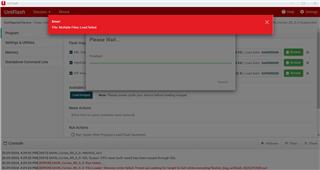
Any idea how to continue?
Thank you in advance.


